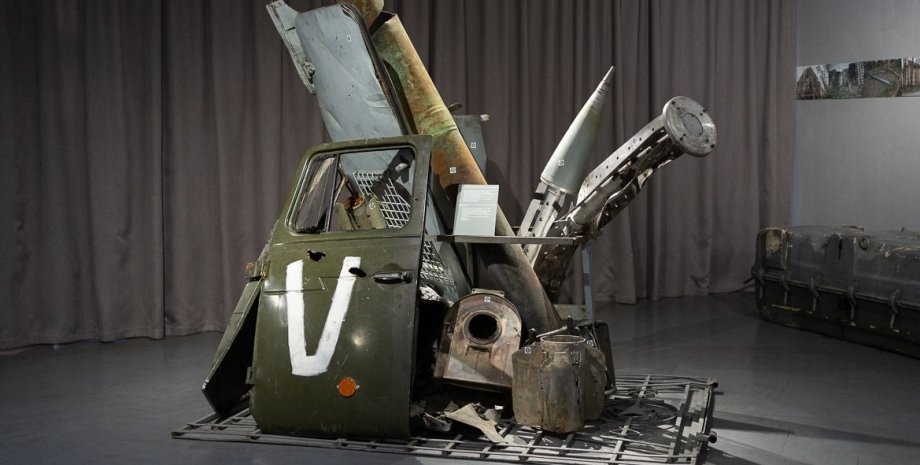
 By Eliza Popova
By Eliza Popova
Last year, for the first time in the history of the country, a cultural institution was awarded the Museum Oscar: the exposition "Ukraine - Crucifixion" of the National Museum of History of Ukraine in the Second World War was awarded the International Museum and Heritage Awards. The award in London was awarded the CEO of the Museum Yuri Savchuk.
The exhibition showed record indicators: 500,000 people have visited in Kiev in the last two years, including many diplomats, foreign delegations and world media. The focus will tell you how the museum has achieved such results. Historian Yuri Savchuk won the competition for the post of CEO of the Museum of War and began his duties in December 2021. Two months later, a full -scale invasion of the Russian Federation into Ukraine began.
The director realized that his Museum of War in combat times was different: the war was not about ten years in the past, no - she has raged here and now - in the present. "I realized that everything that is happening now should be recorded for recent history, document the events and facts of the ongoing war," - says focus Yuriy Konstantinovich. The first expedition was held from April 5 to April 16, 2022: with the permission of the military headquarters and personally Valery Zaluzhny.
During these days, Savchuk took 2000 pictures with employees: Bucha, Gostomel, Borodyanka, Makariv, Chernihiv. Hundreds of artifacts were collected. The first is the ammunition of the invaders: uniforms, helmets, boots. The second is weapons, shells. The third is fragments of destroyed schools and churches. The collection appeared semi -burned icons, crosses, parts of domes.
The director, knowing that today the urgent language of museum exhibitions is the language of metaphor, invited the capital artist Anton Logov to make artifacts of artifacts brought artifacts to give the collected material symbolic sound. Two months after the invasion, in May 2022, the first version of the exposition "Ukraine - Crucifixion" was opened in the Museum of War. Our museum has become the first museum of the war of offline.
"We are met by a red star made from the boots of Russian occupiers. The occupier's boots are familiar to all and a clear symbol of aggression and violence for any people," says the CEO. ". According to the author's plan, these boots of the invaders turned back abroad - inside the Red Star, as the ghosts of the Soviet past. "The exposition itself is divided into two parts -" horde "and" crucifix which they tried to reach their "Russian world".
The museum had neither money nor additional showcases for a new exposition, and then we came up with the use of empty containers from Russian Buk missiles. It turned out that it was symbolic - this is the best option for demonstration occupation artifacts. " Among their products, we see canned chicken with the inscription: "From Zapad to Vostok we do not brown. " And next to the chevrons of the Russian soldiers: "ZA will victim.
" Those who prepared the invasion of Ukraine in the Russian Federation differently beat these two Latin letters, punishing and playing meanings. But soon the occupiers will not get to games. We see a nominal helmet of the Russian pilot by the name of Safargaleyev - commander of the helicopter squadron who attacked Gostomel on the first day of a full -scale invasion. His first was shot together with six more helicopters.
"The helmet was handed us from the Main Directorate of Intelligence," Savchuk said. Particularly interesting is the gift of the Valery Zaluzhny Museum - this is a Russian map of Kiev occupation with labeled infrastructure. "We only show a piece of map, we have completely been banned from our competent authorities. We will launch after the war," the director smiled. In the other hall, the mass of Russian weapons: parts of rockets and mines.
"There is a key installation here: a cross from windows that set out mines of 82 caliber that could fly into our windows. The invaders killed our people - children, old. Their ideology is the ideology of violence, destruction, which symbolizes the cross from mines, which they They wanted to put on our lives, but it didn't work, "Savchuk notes. The Ukrainian part of the exposition includes two sites.
And they are exactly psychologically calculated: the first causes a depressed mood, and the second inspires and gives hope. "Shelter" is a reconstruction of the bomb shelter in Gostomel. We go down into the basement where the cold and the darkness. "It is a precisely reproduced shelter near Antonov's aerodrome in Gostomel. There is an old Soviet military town where civilians - workers of Antonov plant have long lived. Savchuk says.
- On the first day of the war, by 11 am there were minibuses, although from the eighth Russian helicopters fired the territories. This paradox explains the suddenness of the event. There were 200 people in the shelter - all of them became hostages of the situation. 80 people were deported to Belarus: whom There were relatives or at will. Then they returned to Ukraine through Poland. You will go out here for fifteen minutes and cold - humidity, darkness.
These 120 people are mostly women, elderly and children - under 10 years of age. So the drawings are here - Something had to take up children. Icons on the walls. And below-gambling cards, chess. There were unfamiliar and strangers with each other 37 days in the bomb shelter. From supermarkets. The children played with toy tanks while the real top went, "the CEO says. We approach the memorial plate on the floor. " Two corpses were here for a while. One woman named Gritsenko died.
She was born during World War II, and died during this. She, already a widower, made such a memorial plate. The woman was buried just before entering the bomb shelter. All the people who were here controlled Kadyrov. The fight above all these 37 days has not stopped, "Savchuk says, accompanying us with a semi-dark basement. In the dull light of fragments of LED tubes, you can distinguish between mothers and boxes. Of course, any Ukrainian immediately remembers hours spent in such places.
Most often, in the first days of invasion were ordinary technical premises: basements of nine -storey buildings, five floors, schools and kindergartens. - I found on April 6 in the Gostomel shelter of two to three people. They have not yet been taken away by relatives or acquaintances. Someone was nowhere to go as one single elderly woman.
And in Gostomel then there were queues of people who wanted to return to their homes - our military checked not only the replaced doors, but also territories, apartments. And when the residents finally got to their homes and apartments, they were closed after the occupiers, with piles of excrement. People were shocked . . . We asked for these mattresses for residents - for exposition.
At first, people did not understand, "What is the museum?" And then they began to help us, came to discoveries, and even shared with TV our stories, for which we were very grateful for them. "The" shelter "of the" shelter "went to the confessions of these people. There were many ambassadors and representatives of foreign media. The words of the director, no matter how high status of guests, they immediately took care of the mood that he causes him in such horrible conditions.
"We were carrying foreign delegations here. The strongest reaction, I remember, was one high -ranking foreign official, - continues the excursion Yuri Konstantinovich. - They drove such an important escort. He came here and then . . . came out by another man. " Right in the middle of the center of the hall on the ropes hangs a damaged huge icon of "removal from the Cross" from the destroyed by the occupiers of St. Demetrius Rostov (Makariv village).
Below it is a glass showcase with a fire of icons of Christ and Our Lady from the Baby. From the village of Lukyanivka, Kyiv region. "The church was wooden - it burned to ashes. And in this ashes we found the icons, "-sighs, says Savchuk. And under the ceiling-it seems that the dome with the cross of the temple of the Ascension of the Lord. Not far from him is a mowed frame, on which the paintings of the famous artist Maria Primachenko from Ivankovsky-Kraekivka hung from him. museum.
We observe the projected image of Maria Primachenko's painting "Atomic War - Be damned" (1978): a monster, from which a tongue in the form of two snakes breaks out of the mouth. "Today this work is more relevant - in the light of Russian nuclear threats," Savchuk. - We went to several expeditions to the liberated territory - volunteers were cleaned there. We appeared to collect artifacts literally on the third day after release. I was struck by Balaklius.










All rights reserved IN-Ukraine.info - 2022